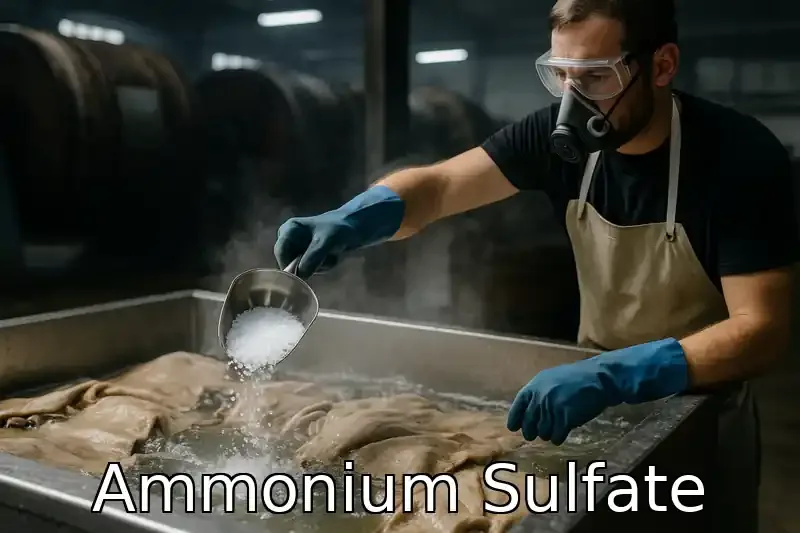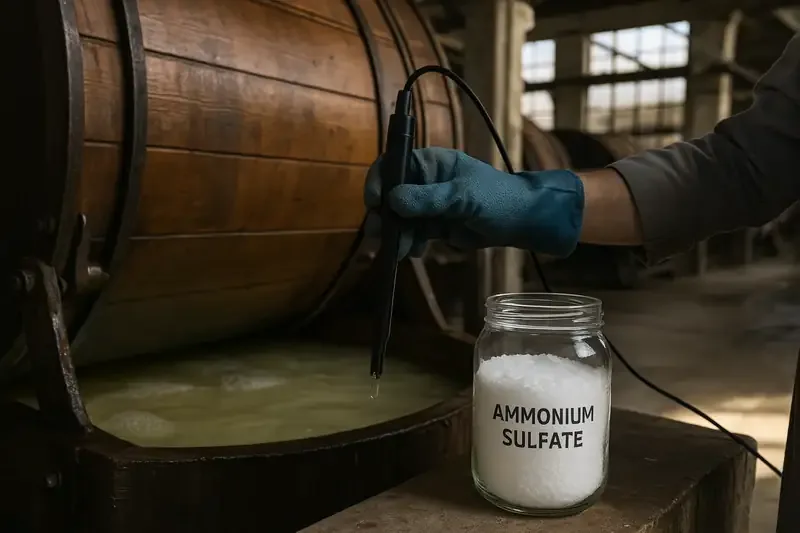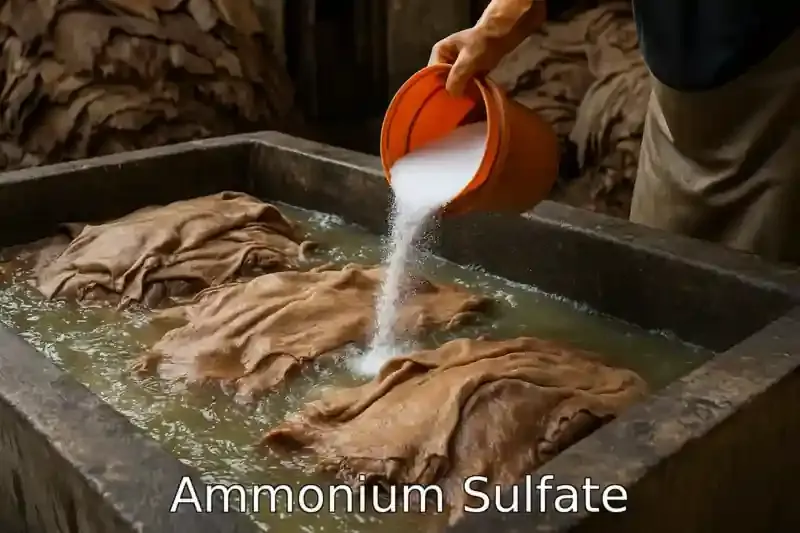Application of Ammonium Sulfate in the Leather and Tanning Industry

During this process, various chemicals are used to prevent the raw hide from decomposition, remove excess hair, and stabilize structural proteins. One very important material that has gained a special place in leather factories in recent decades is Ammonium Sulfate (NH₄)₂SO₄. Due to its unique chemical and physical properties, it can directly improve the final quality of leather at different stages of tanning, including:
Soaking
Deliming
Hair removal (Unhairing)
Collagen stabilization
From an industrial perspective, the use of ammonium sulfate not only enhances final leather quality but also reduces lime consumption and environmental pollution, making it a smart choice for modern industries.
Application of Ammonium Sulfate in the Leather and Tanning Industry
Role of Ammonium Sulfate in the Tanning Process
The tanning process consists of several sequential stages, each requiring specific chemicals to prepare the hide and transform it into leather. Ammonium sulfate is one of the most commonly used mineral compounds and plays a role in several key stages:
1. Soaking
In the first stage, raw hides are soaked in water and chemicals for a specific period to remove dirt, dried blood, salts, and other impurities. Adding ammonium sulfate in this stage helps to:
Facilitate water penetration into the hide fibers
Soften collagen fibers
Reduce the initial microbial load on the hide
This helps prepare the hide for subsequent processing.
2. Deliming
After liming, which swells the hide and loosens hair, excess lime must be removed to prevent fiber damage. Ammonium sulfate acts as a mild acidic salt in this stage and helps:
Completely remove residual lime
Reduce the pH of the hide to an optimal level
Prepare collagen fibers for tanning with chromium or vegetable tanning agents
3. Hair Removal (Unhairing)
One of the most critical stages in tanning is hair removal. Using ammonium sulfate in combination with sodium sulfide and other chemicals helps to:
Accelerate the breaking of protein bonds around hair follicles
Remove hair more easily without damaging the hide structure
Reduce sodium sulfide consumption, thus minimizing unpleasant odors
This feature is now a standard practice in many modern leather factories.
4. Collagen Stabilization
After primary tanning, ammonium sulfate can act as a collagen stabilizer, leading to:
Increased mechanical strength of leather
Prevention of long-term spoilage
Improved dye uptake in finishing stages
Ammonium Sulfate Usage Details (Former Table Information)
Deliming: Recommended usage 2–4% of hide weight. Reduces hide pH and prepares the hide for enzyme treatment. Partially replaces lactic acid and formic acid.
Unhairing: Recommended usage 3–5% of hide weight. Helps break disulfide bonds in hair. Reduces the need for hazardous sodium sulfide.
Bating (Enzyme Softening): Recommended usage 1–2% of hide weight. Improves enzyme activity in softening hides. Partially replaces mineral acids.
Chrome Fixing: Recommended usage 0.5–1% of hide weight. Better stabilization of chromium ions. Increases color uniformity and leather strength.
Final Tanning: Usage varies depending on leather type. Improves softness, reduces spotting, and enhances dye uptake. Partially replaces sulfuric acid.
Advantages and Disadvantages of Using Ammonium Sulfate in Leather Tanning
Advantages:
High efficiency in deliming: Its mild acidic property completely removes excess lime while preserving collagen fibers.
Cost reduction: More economical than some other chemical compounds, saving production costs.
Improved leather quality: Enhances softness, flexibility, and mechanical strength.
Reduced sulfide usage: Helps reduce sodium sulfide consumption during hair removal, improving both environmental impact and odor.
Compatibility with various leather types: Effective for both light leather (e.g., goat, sheep) and heavy leather (e.g., cow, buffalo).
Disadvantages:
Risk of over-acidification: If dosage is not controlled, it may excessively lower pH and damage collagen fibers.
Transportation cost: Due to its higher weight compared to some alternatives, shipping may be more expensive.
Wastewater management required: Excessive use can increase the concentration of mineral salts in tannery wastewater, requiring proper treatment.
Comparison of Ammonium Sulfate with Other Chemicals
Sodium Sulfide: Stronger for hair removal but produces a very unpleasant odor and environmental issues. Ammonium sulfate generates less odor and reduces sulfide use, but is not sufficient alone for complete hair removal.
Formic Acid: Quickly lowers pH and acts fast in deliming. Ammonium sulfate works slower but provides better pH control and causes less damage to collagen fibers.
Ammonium Chloride: Similar pH-adjusting effect but usually more expensive. Ammonium sulfate is more economical and widely available.
Sulfuric Acid: Highly corrosive; ammonium sulfate is safer and easier to handle.
Lactic Acid: Widely used for deliming but more expensive; ammonium sulfate is a cost-effective alternative.
Environmental Effects and Sustainability Benefits
Odor reduction: Unlike sodium sulfide, ammonium sulfate produces less odor, improving working conditions.
Reduced sulfur pollution: Partial replacement of sulfides reduces sulfur compounds in wastewater.
Compliance with environmental standards: Meets EU and US safety and biodegradability regulations.
Recycling and reuse: Can be recovered from wastewater and reused, even as fertilizer in agriculture, enhancing sustainability.
Safety Measures for Ammonium Sulfate in Tanning
Storage Safety:
Keep in a dry and cool environment.
Avoid direct contact with moisture.
Store bags on wooden or plastic pallets to prevent ground moisture damage.
Usage Safety:
Workers should wear gloves, goggles, and masks to minimize direct contact.
Dissolve in water slowly with proper stirring to avoid sudden vapor release.
Ensure proper ventilation in tanning halls.
Transport Safety:
Transport in multilayer polypropylene bags or 1000-kg jumbo bags.
Avoid direct contact with strong acids and oxidizing agents.
Price and Purchasing Considerations
Factors affecting price:
Purity: 99% ammonium sulfate is recommended; lower purity may leave insoluble residues.
Country of origin: China, Iran, Turkey, and India are major suppliers. Chinese products are generally cheaper, but Iranian and Turkish products are often preferred for stable quality.
Packaging: 25 kg bags for small workshops; 1000 kg jumbo bags for industrial use. Packaging choice affects transportation costs.
Currency and shipping fluctuations: Logistics and currency changes affect the final market price in Iran.
Purchasing Recommendations:
Buy from reputable suppliers providing a Certificate of Analysis (COA).
Ensure the product dissolves easily in water and is free of insoluble impurities.
Purchase from established brands to guarantee consistent quality and results.
Why Choose a Reliable Ammonium Sulfate Brand?
Ammonium sulfate plays a vital role in leather tanning, from deliming to color stabilization and improving leather softness. Using this compound ensures:
Higher-quality leather
Greater durability
Uniform and stable color
Brands providing high-purity, water-soluble ammonium sulfate with standard packaging are the best choice for tanneries and leather workshops. Using them increases efficiency, reduces waste, and produces globally competitive leather.
FAQ: Ammonium Sulfate in Leather Tanning
What role does ammonium sulfate play in tanning?
Mainly used in deliming and enzyme stages to reduce pH and prepare the hide for further processing.Why is it a better alternative to sulfides?
Produces milder odor, is more environmentally friendly, and generates less alkaline wastewater.Does it affect final leather quality?
Yes, it improves color fixation, surface uniformity, and product durability.Recommended consumption?
Typically 1–3% of raw hide weight, depending on leather type and tanning process.Is it safe for workers and the environment?
When used according to safety instructions, it is less hazardous than many chemical salts and can be recycled or reused in other industries such as agriculture.
References


